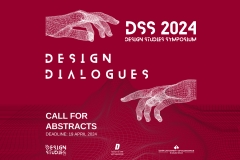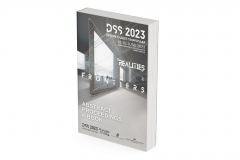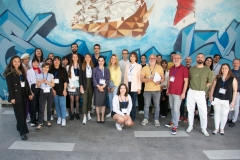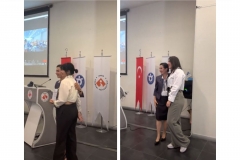
GRADUATE SCHOOL
Design Studies (With Thesis)
FFD 502 | Course Introduction and Application Information
| Course Name |
Current Topics in Art and Design
|
|
Code
|
Semester
|
Theory
(hour/week) |
Application/Lab
(hour/week) |
Local Credits
|
ECTS
|
|
FFD 502
|
Fall/Spring
|
3
|
0
|
3
|
7.5
|
| Prerequisites |
None
|
|||||
| Course Language |
English
|
|||||
| Course Type |
Elective
|
|||||
| Course Level |
Second Cycle
|
|||||
| Mode of Delivery | - | |||||
| Teaching Methods and Techniques of the Course | DiscussionQ&ACritical feedbackLecture / Presentation | |||||
| Course Coordinator | ||||||
| Course Lecturer(s) | ||||||
| Assistant(s) | - | |||||
| Course Objectives | Today, on the fragmented urban patterns, the modern identities challenge the feeling of placelessness in the city. The architects have different strategies, some of them prefer the most irregular shapes and forms, some of them follows historicist eclecticism or some of them looks at constructing the program of the building with a lucid and humble language. This course helps ones contextualize the art and architectural history. History in context sheds lights upon comparative thinking and provides new vantage points while writing and designing. |
| Learning Outcomes |
The students who succeeded in this course;
|
| Course Description | The course focuses on the design discourses of 20th century modern world to understand the bases of today's contemporary approaches. Almost each topic is discussed through the center periphery theory so as to see the continuities and discontinuities between the design approaches and historical periods not only in the center but also in the periphery. |
|
|
Core Courses | |
| Major Area Courses | ||
| Supportive Courses |
X
|
|
| Media and Management Skills Courses | ||
| Transferable Skill Courses |
WEEKLY SUBJECTS AND RELATED PREPARATION STUDIES
| Week | Subjects | Related Preparation |
| 1 | INTRODUCTION: IS MODERNITY ANTI-MODERNIST? ROMANTICISM, ORIENTALISM, AND RUIN PASSION Announcement of Assignment I. In class discussions. | Assignment I: Park regulations and Olmstead( Olmsted, F., L., 1971, “Expanding Cities: Random vs Organized Growth”, Civilizing the American Cities: Writings on City Landscapes, p:21-42, MIT Press) |
| 2 | URBANIZATION AND PUBLIC HEALTH Announcement of Assignment II. In class discussions | Assignment II: Martin Jay, Dialectic Imagination: History of the Frankfurt School and the Institute of Social Research, 1923-50, H.E.B. |
| 3 | IN THE ECLIPSE OF WAR AND ITS AFTERMATH Announcement of Assignment III. In class discussions. | Assignment III: Louis I. Kahn, “On Monumentality” (1944) Louis I. Kahn, “Architecture is the Thoughtful Making of Spaces” (1957) Counter Argument Heidegger ‘Building, Dwelling, Thinking’ |
| 4 | MONUMENTAL AND HEROIC AND ITS COUNTER ARGUMENTS Announcement of Assignment IV. In class discussions. | Assignment IV: Reyner Banham, “The New Brutalism” (1955) Ben Highmore,``Image-breaking, God-making'': Paolozzi's Brutalism, October , Spring 2011, Vol. 136, New Brutalism (Spring 2011), pp. 87-104 |
| 5 | ABSTRACTION OF 20TH CENTURY & THE ANTI-ARTISTS OF 50’S Announcement of Assignment V. In class discussions. | Assignment V: Hans-Georg Gadamer, The rehabilitation of authority and tradition Truth and Method, Continuum Publishing Groups, (London& NY), 1975, 278-285 Didem Yavuz, Art and Architecture Association in between 50s to 70s”, article, Mimarlık, issue 344, November- December 200 |
| 6 | WHICH TRADITION? MODERN VS VERNACULAR Announcement of Assignment VI. In class discussions. | Assignment VI: Victor Gruen, “Cityscape & Landscape” (1955) Jane Jacobs, “Death and Life of Great American Cities” [excerpt] Announcement of term project |
| 7 | URBANISM & SUBURBANISM Announcement of Assignment VII. In class discussions. | Assignment VII: Jean Baudrillard, “The Beaubourg-Effect: Imposion and Deterrence” (1982) |
| 8 | NEO-FUTURISM AND ANOTHER HYPER-REALITY? Announcement of Assignment VIII. In class discussions. | Assignment VIII: Denise Scott Brown, "Learning from Pop" (1971) - Antony A Grudin; A Sign of Good Taste': Andy Warhol and the Rise of Brand Image Advertising, Oxford Art Journal, Vol. 33, No. 2 (2010), pp. 211-232. |
| 9 | POP & POSTMODERN: Announcement of Assignment IX. In class discussions. | Assignment IX: Morgan Shipley, Hippies and the Mystic Way: Dropping Out, Unitive Experiences, and Communal Utopianism, Utopian Studies , Vol. 24, No. 2 (2013), pp. 232-263. Aldo Rossi, “Urban Artifacts & a Theory of the City,” The Architecture of the City (1966) |
| 10 | LONG 60s AND RETHINKING CLASSICISM? Announcement of Assignment X. In class discussions. | Assignment X: Colin Rowe, “Introduction to Five Architects” (1972) Peter Eisenman, “Post-Functionalism” (1976) |
| 11 | THE MODERNISM: BECOMING TRADITION Announcement of Assignment XI. In class discussions. Student presentations | Assignment XII: Ben Agger, Critical Theory, Poststructuralism, Postmodernism: Their Sociological Relevance, Annual Review of Sociology , 1991, Vol. 17 (1991), pp. 105-131 Gülsüm Baydar, Toward Postcolonial Openings: Rereading Sir Banister Fletcher's "History of Architecture", Assemblage , Apr., 1998, No. 35 (Apr., 1998), pp. 6-17 |
| 12 | DECONSTRUCTING THE IDEA: Deconstructivism through the lense of Poststructuralism, Postcolonilism, and Postmodern Announcement of Assignment XII. In class discussions. | Assignment XIII: Stan Allen, “Terminal Velocities” & Thom Mayne, “Change or Perish” (2005) |
| 13 | DIGITAL ABSTACTION AND MATERIALITY: What happened to standardization? Announcement of Assignment XIII. In class discussions. | Assignment XIV: Stan Allen Assemblage, No. 27, Tulane Papers: The Politics of Contemporary Architectural (Aug., 1995), pp. 47-54 |
| 14 | THE UTOPIA/Collective vs individual In class discussions. Announcement of Final Project. | |
| 15 | Review of the semester | - |
| 16 | Review of the semester |
| Course Notes/Textbooks | - |
| Suggested Readings/Materials | Frampton, K., Modern Architecture A Critical History, Thames & Hudson, ISBN: 0-500-20257-5 Margolin, V., World History of Design, Bloomsbury Academic, ISBN: 978-1472569288 |
EVALUATION SYSTEM
| Semester Activities | Number | Weigthing |
| Participation |
1
|
10
|
| Laboratory / Application | ||
| Field Work | ||
| Quizzes / Studio Critiques | ||
| Portfolio | ||
| Homework / Assignments |
6
|
30
|
| Presentation / Jury |
2
|
60
|
| Project | ||
| Seminar / Workshop | ||
| Oral Exams | ||
| Midterm | ||
| Final Exam | ||
| Total |
| Weighting of Semester Activities on the Final Grade |
16
|
100
|
| Weighting of End-of-Semester Activities on the Final Grade | ||
| Total |
ECTS / WORKLOAD TABLE
| Semester Activities | Number | Duration (Hours) | Workload |
|---|---|---|---|
| Theoretical Course Hours (Including exam week: 16 x total hours) |
16
|
3
|
48
|
| Laboratory / Application Hours (Including exam week: '.16.' x total hours) |
16
|
0
|
|
| Study Hours Out of Class |
13
|
5
|
65
|
| Field Work |
0
|
||
| Quizzes / Studio Critiques |
0
|
||
| Portfolio |
0
|
||
| Homework / Assignments |
3
|
25
|
75
|
| Presentation / Jury |
2
|
27
|
54
|
| Project |
0
|
||
| Seminar / Workshop |
0
|
||
| Oral Exam |
0
|
||
| Midterms |
0
|
||
| Final Exam |
0
|
||
| Total |
242
|
COURSE LEARNING OUTCOMES AND PROGRAM QUALIFICATIONS RELATIONSHIP
|
#
|
Program Competencies/Outcomes |
* Contribution Level
|
||||
|
1
|
2
|
3
|
4
|
5
|
||
| 1 | to be able to expand the practical knowledge gained in undergraduate programs with theoretical field of design research, |
X | ||||
| 2 | to be able to examine, interpret data and assess concepts and ideas with research methods of design theory and social sciences, |
X | ||||
| 3 | to be able to identify problems of design disciplines in times of global / environmental crisis and to be able to develop possible solutions for design practitioners, |
X | ||||
| 4 | to be able to expand knowledge on the history of material culture as it relates to design practices of the past, |
X | ||||
| 5 | to be able to promote research on local practices of everyday life and assess the outcome to implement design solutions, |
X | ||||
| 6 | to be able to facilitate interactions in between varied design disciplines and to promote collaborative work to solve complex problems, |
X | ||||
| 7 | to be able to process outcome of design research to be applied in design education, |
X | ||||
| 8 | to be able to instigate research on the new tools, technologies and materials of production in order to accelerate changes in design practices, |
X | ||||
| 9 | to be able to develop an ethical approach towards design professions in order to install social and environmental responsibilities, |
X | ||||
| 10 | to be able to use a foreign language for both chasing the scientific publication and developing proper communication with colleagues from other countries, in written and verbal ways. |
X | ||||
| 11 | to be able to use computer programs needed in the field design as well as information and communication technologies in advanced levels (“European Computer Driving Licence”, Advanced Level”). |
|||||
*1 Lowest, 2 Low, 3 Average, 4 High, 5 Highest
NEWS |ALL NEWS

DSS 2024 CALL FOR PAPERS | THEME: DESIGN DIALOGUES
DSS 2024 CALL FOR PAPERS THEME: DESIGN DIALOGUES The Design Studies Graduate Program and the Faculty of Fine Arts and Design at the Izmir

Abstract Proceedings e-Book for the Design Studies Symposium 2023 is available now!
The Design Studies Symposium 2023 (DSS 2023), organized in collaboration with İzmir University of Economics Graduate School Design Studies Master's and PhD

Design Studies Symposium 2023: Realities & Frontiers
The Design Studies Symposium 2023 (DSS 2023) organized by the IEU Graduate School Design Studies programs was held on 1-2 June, at

The Best Paper Award at the Design Studies Symposium 2023: Realities & Frontiers
The voting for the best presentation award at the Design Studies Symposium 2023 (DSS 2023) organized by the IEU Graduate School Design




